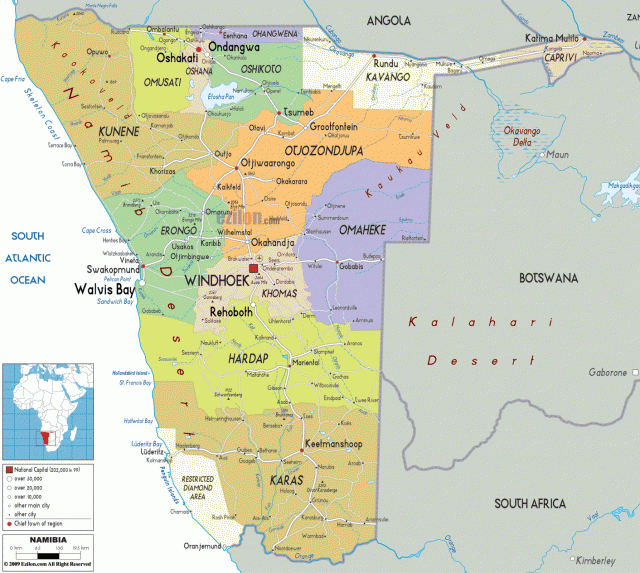Namibia
Area 318,696 square mi (825,418 square km)
Population 2.403 million (2014)
Capital Windhoek
Highest Point 8,550 ft (2,606 m)
Lowest Point 0 m
GDP $13.43 billion (2014)
Primary Natural Resources diamonds, gold, tin, copper, lead, zinc.
NAMIBIA, FORMERLY known as South West Africa (SWA), is located in southern Africa. It borders the South ATLANTIC OCEAN, NAMIBIA, ANGOLA, BOTSWANA, SOUTH AFRICA, and ZAMBIA. Namibia can be divided into four major geographical segments. In the west, stretches the great Namib Desert, which extends along the Atlantic coast from the northern part of South Africa to the southern border with Angola. This desert belt varies in width from about 62 mi (100 km) in the south to as much as 680 mi (1,100 km) in the north, and has mighty sand dunes in the central part up to 1,968 ft (600 m) high. The northern and the southern extremes of the desert are predominantly gravel fields.

Moving inland, the desert belt gives way to the escarpment, a mountain wall up to 6,500 ft (2000 m) high. Beyond the escarpment, the land changes into the Central Plateau region, which slowly descends toward the east. The majority of Namibian towns and villages lie on this plateau, including the capital of Windhoek at 5,425 feet (1,654 m). Farther to the east lies the Kalahari Basin and the great KALAHARI DESERT, which is characterized by wide sandy plains and long-dunes with scarce vegetation.
Another unique geographical area is the relatively rainy Kavango and Caprivi region in the extreme northeast. It is flat and covered with dense bushveld. Because the climate is continental, tropical, and very dry, most of Namibia's rivers are dry except during rains. Perennial rivers, such as the Okavango, Kunene, Zambezi, and Orange are confined to Namibia's northern and southern borders areas. The coast is cooled somewhat by the BENGUELA CURRENT. The meager and highly variable precipitation is not very effective in watering the land because of a high rate of evaporation. Average rainfall increases from the southwest to the northeast. The territory suffers from prolonged, periodic droughts. The vegetation is generally sparse except in the far north.
Namibia's widely varied animal life includes the lion, leopard, elephant, rhinoceros, giraffe, zebra, ostrich, and antelope. The country's most renowned game reserve is the Etosha National Park, one of the largest in the world. Namibia has relatively abundant natural resources. Among the most significant are iamonds, particularly those that can be found in the sands of the Namib Desert along the Atlantic coast. Like South Africa, there are also important deposits of gold. Namibia is a sparsely populated multiracial country where half of the population is concentrated in the northern region known as Ovamboland. The Ovamboland is home to many ethnic groups, including the Ovambos, who represent 50 percent of the population, and the Kavangos and Caprivians. The white settlers (6 percent) occupy the central and southern highlands along with other smaller, ethnic groups. The white population consists of Afrikaners, British, and Germans. In 1990, the country became an independent nation after a long period of liberation struggle. Since then, the country has been stable politically under Sam Nujoma, who led a prolonged fight against South African rule in Namibia.